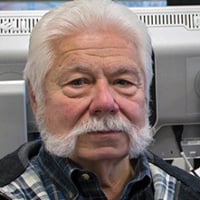Auditory Research Laboratory
Principal Investigators
 Dr. Wei Qiu
Dr. Wei Qiu
Director
Senior Research Scientist
Email: [email protected]
Phone: 518-564-7706
 Dr. Roger P. Hamernik
Dr. Roger P. Hamernik
Distinguished Professor Emeritus
Email: [email protected]
Phone: 518-564-7701
Research Interests
Research in this laboratory has focused on the evaluation of hearing hazard from industrial and military noise exposures. The primary goal of this research is to develop and test the validity of an alternate approach to noise analysis for the purpose of hearing conservation which will more precisely predict the audiometric and morphological consequences of an exposure.
Our group originally introduced the idea of using the kurtosis as an index of the hazard to hearing from equal energy noise exposures. In a series of animal (chinchilla) experiments, we explored the use of kurtosis to predict hearing damage in the chinchilla model. The effects in terms of temporary threshold shift, asymptotic threshold shift, permanent threshold shift, inner hair cell loss, and outer hair cell loss were measured. The noise stimulus was varied in terms of overall level, background level, peak level, interpeak interval, intermittency schedule, frequency, and frequency bandwidth. Each experiment built upon the findings of the previous one, further refining the role of kurtosis and its modifications as a predictive tool. We have shown that an energy metric in combination with the statistical metrics of frequency- and time-domain kurtosis will provide necessary and possibly sufficient information on essentially any industrial noise environment to evaluate its potential for causing hearing loss.
Our current research efforts are aimed to (1) an industrial study of the kurtosis metric for evaluation of noise-induced hearing loss – we are conducting a large scale epidemiological study of the kurtosis metric in complex noise environments in human populations. We are also investigating methods of measuring complex noise that best characterize the adverse effects on hearing; (2) the study of cochlear synaptopathy in humans associated with industrial noise exposure – we are investigating whether cochlear synaptopathy occurs in noise-exposed workers. We are also investigating the association between the type of noise exposure and noise-induced cochlear synaptopathy.
Research Projects
- An industrial study of the kurtosis metric for evaluation of noise-induced hearing loss
- The study of cochlear synaptopathy in humans associated with industrial noise exposure
- Data collection of complex noises of industrialized workers in Zhejiang province of China
- Hearing hazard associated with industrial noise exposure
- The use of drugs to reduce hearing loss following acute acoustic trauma
- Model for prediction of noise-induced hearing loss
Active Research Collaborations
- Drs. Thais Morata, William Murphy and Chucri Kardous (National Institute for Occupational Safety and Health, USA)
- Dr. Pierre Campo (Institut National de Recherche et de Sécurité, France)
- Dr. Meibian Zhang (Zhejiang Provincial Center for Disease Control and Prevention, China)
- Professors Richard Salvi and Wei Sun (Center for Hearing and Deafness, State University of New York at Buffalo, USA)
- Prof Barbara Shinn-Cunningham (Center for Computational Neuroscience and Neural Technology , Boston University, USA)
- A/Prof Adrian Fuente (École d'orthophonie et d'audiologie, University of Montreal , Canada)
- Professors Jingsong Li and Nai Ding (College of Biomedical Engineering, Zhejiang University, China)
- Prof Weichao Xu (School of Automation, Guangdong University of Technology, China)
- Prof Lianwen Jin (School of Electronics and Information, South China University of Technology, China)
- A/Prof Jun Qin (Department of Electrical and Computer Engineering, Southern Illinois University, USA)
Facilities, Technology & Special Equipment
- The Auditory Evoked Potential Laboratory
- The Otoacoustic Emissions Laboratory
- The Acoustics & Vibration Laboratory
- The Cochlear Anatomy Laboratory
Research Publications
- H. Xie, W. Qiu, N.J. Heyer, et al. (2016). The use of the kurtosis-adjusted cumulative noise exposure metric in evaluating the hearing loss risk for complex noise. Ear & Hearing. 37(3):312-323. PMID:26671317
- W. Qiu, M.B. Zhang, and R.P. Hamernik (2015). Role of the kurtosis metric in evaluating hearing trauma from complex noise exposures — from animal experiments to human applications. J. Acoust. Soc.Am. 138(3):1773. http://dxdoi.org/10.1121/1.4933610
- P.F. Sun, J. Qin, and W. Qiu (2015). Development and validation of a new adaptive weighting for auditory risk assessment of complex noise. Applied Acoustics 103:30-36. http://dx.doi.org/10.1016/japacoust.2015.10.004
- W. Qiu, R.P. Hamernik, R.I. Davis (2013). The value of a kurtosis metric in estimating the hazard to hearing of complex industrial noise exposures. J. Acoust. Soc.Am. 133(5): 2856-2866. PMID:23654391
- R.I., Davis, W. Qiu, N.J. Heyer, et al., (2012). The Use of the Kurtosis Metric in the Evaluation of Occupational Hearing Loss in Workers in China: Implications for Hearing Risk Assessment. Noise and Health, 14: 330-342.PMID:23257587
- Y.M. Zhao, W. Qiu, L. Zeng, et al., (2010). Application of the kurtosis statistic to the evaluation of the risk of hearing loss in workers exposed to high-level complex noise. Ear & Hearing 31:527-532.PMID:20588120
- R.I. Davis, W. Qiu and R.P.Hamernik (2009). Role of the kurtosis statistic in evaluation complex noise exposures for the protection of hearing. Ear & Hearing, Vol. 30, No. 5, 628-634. PMID:19657275
- R.P.Hamernik, W. Qiu and B. Davis (2008). The effectiveness of N-acetyl-L-cysteine (L-NAC) in the prevention of severe noise-induced hearing loss. Hearing Research 239: 99-106. PMID:18329204
- W. Qiu, R.P. Hamernik, B. Davis (2007). Hearing loss from interrupted, intermittent and time varying Gaussian noise exposures: The application of the equal energy hypothesis. J. Acoust. Soc.Am. 121(3): 1613-1620. PMID:17902860
- R.P. Hamernik, W. Qiu, B. Davis (2007). Hearing loss from interrupted, intermittent and time varying non-Gaussian noise exposures: The application of the equal energy hypothesis. J. Acoust. Soc.Am. 122(4): 2245-2254.
- W. Qiu, R.P. Hamernik, B. Davis (2006). The kurtosis metric as an adjunct to energy in the prediction of trauma from continuous, non-Gaussian noise exposures. J. Acoust. Soc.Am. 120(6):3901-3906. PMID:17225417
- W. Qiu, C.Q. Chang, W.Q. Liu, et al., (2006). Real time data-reusing learning of a radial basis function network for tracking evoked potentials, IEEE Trans. on Biomedical Engineering, 53(2):226-237. PMID:16485751
- W. Qiu, J. Ye, X.H. Liu-White and R.P. Hamernik (2005). Model for noise-induced hearing loss using support vector machine. J. Acoust. Soc.Am. 118(3), Pt. 2: 1896. http://dx.doi.org/10.1121/1.4779810
- B. Davis, W. Qiu and R.P. Hamernik (2005), Sensitivity of distortion product otoacoustic emissions in noise-exposed chinchillas, J. Am. Acad Audiol, 16:69-79. PMID:15807046
- B. Davis, W. Qiu and R.P. Hamernik (2004). The use of distortion product otoacoustic emissions in the estimation of hearing and sensory cell loss in noise-damaged cochleas, Hearing Research, 187: 12-24. PMID:14698083
- R.P.Hamernik, W. Qiu and B. Davis (2003). The effects of the amplitude distribution of equal energy exposures on noise-induced hearing loss: the kurtosis metric, J. Acoust. Soc, Am., 114:386-395. PMID:12880050
- R.P.Hamernik, W. Qiu and B. Davis (2003), Cochlear toughening, protection, and potentiation of noise-induced trauma by non-Gaussian noise, J. Acoust. Soc, Am., 113(2), 969-976. PMID:12597190
- W.Qiu, K.S.M.Fung, F.H.Y.Chan, et al., (2002), Adaptive filtering of evoked potentials using a radial-basis function neural network reference input, IEEE Transaction on Biomedical Engineering, 49(3):225-232. PMID:11878313
- R.P.Hamernik, W.A.Ahroon, J.H.Patterson and W. Qiu (2002). Relations among early postexposure noise-Induced threshold shifts and permanent threshold shifts in the chinchilla, J. Acoust. Soc, Am., 111(1), 320-326. PMID:11831804
- R.P.Hamernik and W. Qiu (2001), Energy-independent factors influencing noise-induced hearing loss in the chinchilla model, J. Acoust. Soc, Am., 110(6), 3163-3168.
- R.P.Hamernik, W. Qiu and R.I. Davis (2001). Use of statistical metrics in the evaluation hazardous noise exposures, Noise Induced Hearing Loss: Basic Mechanisms, Prevention and Control (eds. by D.Prasher, D.Henderson, R.J.Salvi and R.P.Hamernik), 331-240, Noise Research Network Publications, London.
- R.P.Hamernik and W. Qiu (2000). Correlations among evoked potential thresholds, distortion product otoacoustic emissions and hair cell loss following various noise exposures in the chinchilla, Hearing Research, 150, 245-257. PMID:11077207